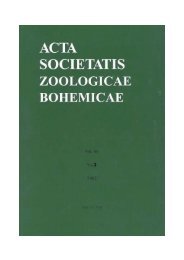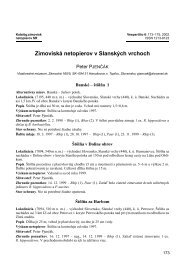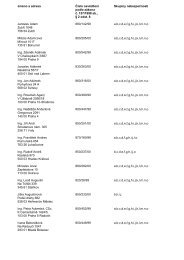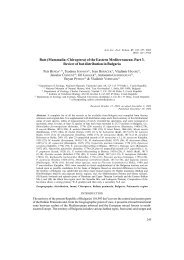You also want an ePaper? Increase the reach of your titles
YUMPU automatically turns print PDFs into web optimized ePapers that Google loves.
Arthropods of Burgess Shale type from the Middle Cambrian of Bohemia (Czech Republic)Acknowledgements. The authors are indebted to RNDr. M.Široký, Ing. L. Mandík and Mr. M. Szabad for offering the specimensfrom their private collections for study. Dr. R. J. Prokop (NationalMuseum, Prague) gave valuable information on echinoderms and evaluationof Pilocystites primitius Barrande and supported, together with Dr.V. Turek, this study in the National Museum, Prague. Our particularthanks go to W. D. J. Rolfe (Edinburgh) for critical reading the manuscript.Doc. Dr. O. Fatka (Institute of Geology and Palaeontology,Charles University) helped with useful advice as a reviewer of themanuscript. Mr. R. J. Duda (Charles University) carefully made thephotographs.ReferencesBarrande J. (1852): Système silurien du centre de la Bohême. Vol. I.Recherches géologiques. Prague, Paris.– (1887): Système silurien du centre de la Bohême. Vol. VII. Cystidées.Prague.Beaver H. H. et al. (1967): Treatise on Invertebrate Paleontology. Part S,Echinodermata 1. Geol. Soc. Amer., Univ. Kansas.Briggs D. E. G. (1977): Bivalved arthropods from the Cambrian BurgessShale of British Columbia. Palaeontology, 20, 595–621.Briggs D. E. G., Erwin D. H., Colier F. J. (1994): The fossils of theBurgess Shale. Smithsonian Institution Press.Brooks H. K., Caster K. E. (1956): Pseudoarctolepis sharpi, n. gen., n. sp.(Phyllocarida), from the Wheeler Shale (Middle Cambrian) of Utah.J. Paleont., 30, 1, 9–14. Tulsa.Chlupáč I. (1999): Barrande’s stratigraphic concepts, palaeontologicallocalities and tradition – comparison with present state. J. Czech Geol.Soc., 44, 1–2, 3–30.Chlupáč I. ed. (1968): Lexique stratigraphique international. Fasc. 6b1.Massif de Bohême. IUGS, Centre Nat. Rech. Sci., 452 pp. Paris.Chlupáč I., Havlíček V., Kukal Z., Kříž J., Štorch P. (1998): Palaeozoicof the Barrandian (Cambrian to Devonian). 183 pp. Czech Geol.Surv., Praha.Conway Morris S., Whittington H. B., Briggs D. E. G., Hughes C. P.,Bruton D. L. (1982): Atlas of the Burgess Shale. PalaeontologicalAssoc.Fatka O. (2000): Das Mittlere Kambrium bei Jince, Tschechische Republik.Europäische Fossillagerstätten (G. Pinna, D. Meischner eds).21–23. Springer.Fatka O., Kordule V. (1992): New fossil sites in the Jince Formation(Middle Cambrian, Bohemia). Věst. Čes. geol. Úst., 67, 1, 47–60.Glaessner M. F. (1979): Lower Cambrian Crustacea and annelid wormsfrom Kangaroo Island, South Australia. Alcheringa, 3, 21–31.Hahn G., Brauckmannn C. (1977): Phyllocariden-Reste (Crustacea) ausdem deutschen Kulm (Unter-Karbon). Senckenberg. lethaea, 58,81–90.Hou X. G. (1987): Three new large arthropods from Lower CambrianChengjiang, eastern Yunnan. Acta Palaeont. Sinica, 26, 3, 272–285.– (1999): New rare bivalved arthropods from the Lower CambrianChengjiang Fauna, Yunnan, China. J. Paleont., 73, 1, 102–116. Tulsa.Hou X. G., Bergström J. (1997): Arthropods of the Lower CambrianChengjiang fauna, southwest China. Fossils Strata, 45, 116 pp. Oslo.Jaekel O. (1899): Stammesgeschichte der Pelmatozoen. 1. Thecoidea undCarpoidea. 442 pp. Springer Berlin.Kordule V. (1996): Význam některých méně známých fosiliferníchlokalit pro stratigrafii jineckého souvrství v českém středním kambriu.Věst. Čes. geol. Úst., 71, 1, 37–49.Kukal Z. (1971): Sedimentology of Cambrian deposits of the Barrandianarea (Central Bohemia). Sbor. geol. Věd, Geol., 20, 53–100. Praha.Lipold M. V., Krejčí J. (1860): In: Verhandlungen der k. k. Geol. Reichsanstalt,Sitzungsbericht vom 24. April, 88–91. Wien.Mergl M., Šlehoferová P. (1991): Middle Cambrian inarticulate brachiopodsfrom Central Bohemia. Sbor. geol. Věd, Paleont., 31,67–102. Praha.Michálek M. (1978): Němý svědek. Mladý svět, 20, 44 pp. Praha.Mikuláš R. (2000): Trace fossils from the Middle Cambrian of the Barrandianarea (Central Bohemia, Czech Republic). Czech Geol. Surv.Spec. Papers, 12, 29 pp. Praha.P’an Kiang (1957): On the discovery of Homopoda from South China.Acta Palaeont. Sinica, 5, 523–526.Raymond P. (1935): Leanchoilia and other Mid-Cambrian Arthropoda.Bull. Mus. Compar. Zoology, 76, 205–230.Resser Ch. E. (1930): New Lower and Middle Cambrian Crustacea. U. S.Nat. Mus., Proc. 76, 9, 1–18.Resser Ch. E., Howell B. F. (1938): Lower Cambrian Olenellus Zone ofthe Appalachians. Bull. Geol. Soc. Amer., 49, 195–248.Robison R. A. (1984): Cambrian Agnostida of North America and Greenland.Part I. Ptychagnostidae. Univ. Kansas Paleont. Contrib., 109,1–60.Robison R. A., Richards B. C. (1981): Larger bivalve arthropods from theMiddle Cambrian of Utah. Univ. Kansas Paleontol. Contrib., 106,1–28. Lawrence.Rolfe W. D. I. (1962): Two new arthropod carapaces from the BurgessShale (Middle Cambrian) of Canada. Breviora Mus. Compar. Zoology,160, 1–9. Cambridge, Mass.– (1969): Phyllocarida. In: Moore R. C., Teichert C. (eds) Treatise oninvertebrate paleontology, Part R, Arthropoda 4, Vol. 1, R296-R331.Geol. Soc. Amer., Univ. Kansas. Boulder.Simonetta A. M., Delle Cave L. (1975): The Cambrian non trilobitearthropods from the Burgess Shale of British Columbia. PalaeontographicaItalica, 69, 1–37.Walcott Ch. D. (1912): Cambrian geology and paleontology II. No. 6.Middle Cambrian Branchiopoda, Malacostraca, Trilobita, andMerostomata. Smithsonian Miscellaneous Collections, 57, 6,145–228.– (1931): Addenda to descriptions of Burgess Shale fossils. SmithsonianMiscellaneous Collections, 85, 3, 1–46. Washington.Yuan Jin-Liang, Zhao Yuan-Long (1999): Tuzoia (bivalved arthropods)from the Lower-Middle Cambrian Kaili Formation of Taijiang,Guizhou. Acta Palaeont. Sinica, 38, Suppl., 91–94. Beijing.Handling editor: Petr ŠtorchExplanation of platesPlate I⇒Tuzoia sp., Jince Formation (upper part), Vinice near Jince (A-C),Rejkovice (D).A, B, C – incomplete right carapace valve VK40 with partly preservedlateral ridge, posteroventral part and doublure; (B – enlarged figure withoutthe anterior part, C – enlarged anterior part with partly exposed doublure);D – fragment of doublure SZ169.Plate II⇒ ⇒Tuzoia sp., Jince Formation near Jince (except F – Velká Bába near Hostomice).A, B, C, D – incomplete right carapace valve VK41, Vinice; A – enlargedposterodorsal part, B – enlarged anterior part, C – enlarged dorsal part, D –the overall view showing the covered median part and broken antero- andposteroventral parts); E – fragmentary dorsal part of the right carapace valvewith posterior edge, L36484; F – fragmentary specimen SZp5964, a toothlikeprojection is probably a hyolithid shell attached to the Tuzoia fragment;G – fragment of a large specimen showing the typical reticulate sculpture,L36482; H – two fragmentary and approached carapace valves showingconfiguration of the dorsal margins and increasing density of reticulatesculpture near the broken lateral ridges, L36481.Plate III⇒ ⇒ ⇒Large tuzoiid arthropod (n. gen.), Jince Formation, Vinice near Jince,Paradoxides gracilis Zone. L36595 (coll. M. Široký), maximum diameter227 mm.A, B – overall views in different light, with different sculpture and imprintedremains of paradoxidid trilobites; C – strongly enlarged part ofthe left medium sector showing the marked difference between the “tuzoiid”polygonal sculpture and the thicker and pitted parts.All photos R. J. Duda179








